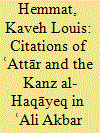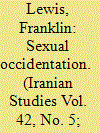| Srl | Item |
| 1 |
ID:
161394


|
|
|
|
|
| Summary/Abstract |
ʿAli Akbar Khatāyi’s Khatāynāmeh (Book of China), a detailed description of state and society in Ming China written in 922/1516, includes citations from the Kanz al-Haqāyeq (attributed to Mahmud Shabestari) and ʿAttār’s Elāhināmeh. By citing these two texts at key points in his description of the Chinese government, Khatāyi articulates a radical political vision in which the civil officials, rather than the emperor, are the true rulers. Furthermore, by using the Kanz al-Haqāyeq as a portal text, and through frequent citations of other gnostic poetry, he crafts his own authorial presence by identifying his own text with fotovvat and gnosticism, and invokes a conceptual framework based on the thought of Ibn ʿArabi epitomized in his intertexts.
|
|
|
|
|
|
|
|
|
|
|
|
|
|
|
|
| 2 |
ID:
092945


|
|
|
|
|
| Publication |
2009.
|
| Summary/Abstract |
This article explores tales and tropes of conversion, especially conversion engendered by romantic attraction for the religious other, in the poetry of Far?d al-D?n 'Att r. The plot dynamics of class, gender and confessional adherence are complex, and hold important clues to the poet's theology. One particularly rich example of the encoding of religious and social boundaries can be found in a body of ghazals written about the beautiful Christian boy (tars -bachcha). The history of this homoerotic sub-genre is traced, and 'Att r's treatment of the theme is explored in juxtaposition not only to earlier authors, but to other motifs of the religious other and of religious conversion, appearing in his own oeuvre, including the narrative of Shaykh San' n with its representation of the Christian girl beloved. The terminology of Christianity and the markers by which 'Att r construes Christian-ness are discussed, and these symbolically amorous encounters with Christianity are analyzed as part of a larger discourse of emasculation which 'Att r constructs around conversion, religious affiliation, and insufficient commitment to spiritual growth. Analysis of the dynamic interplay of markers of gender and class in the tales and topoi dealing with religious conversion or cross-confessional interaction will ultimately afford a perspective into 'Att r's conception of the specific religious traditions juxtaposed to Islam, as well as his beliefs about inter-religious relations.
|
|
|
|
|
|
|
|
|
|
|
|
|
|
|
|